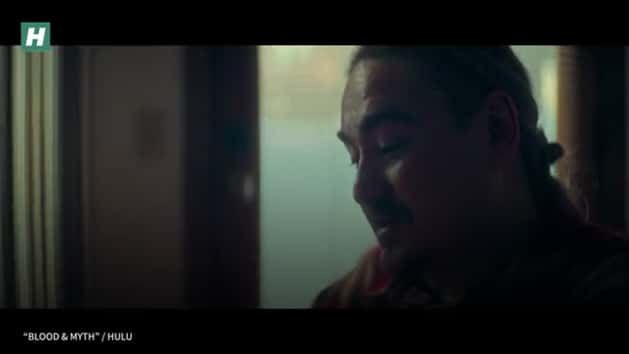Our interview basically begins with an Alaskan proverb.
“They say the veil between myth and reality is very thin up north,” James Dommek Jr. tells me as we talk about “Blood & Myth,” an upcoming Hulu documentary about a series of crimes in an Iñupiaq village in northern Alaska. Dommek serves as the executive producer and narrator of the film, which airs on Hulu in September. The documentary, set in Alaska’s most remote regions and blending true crime and Native folklore, is adapted from the 2019 Audible original “Midnight Son”; it is directed by Kahlil Hudson.
“Blood & Myth” tries to untangle how Teddy Kyle Smith, an Iñupiaq man who was well-known in his community, experienced a supposed encounter with the supernatural — and ended up going on a violent rampage.

Smith is a former Marine who volunteered with elders, taught children traditional Iñupiaq skills and found work as an actor. His part in the 2011 coming-of-age drama “On The Ice” became a point of pride among his people, who saw the film as an authentic representation of their culture after decades of stereotypical portrayals by outsiders. After the film premiered at the Sundance Film Festival, it seemed like Smith was opening doors for the Iñupiaq to have their own voice.
“It seemed like he had so much going for him,” Dommek says in the documentary. “How can someone just go off the rails like that?”
So Dommek was stunned when, in September 2012, he heard Smith had shot two men during a weekslong manhunt that began when he fled the scene of his mother Dolly Smith’s death. Smith is currently serving 99 years in prison for attempted murder. His mother’s death was ruled “undetermined.”
When Smith was arrested 40 miles away from his home in Kiana, Alaska, why he lost control was far from the biggest mystery.

Dommek became fixated on the incident. With a close relationship to the Iñupiaq community in Kiana, Dommek began collecting exclusive information. His once-improvisational investigation reached a turning point when he was tipped off about tapes from Smith’s first interrogation.
In the recordings, Dommek heard Smith make a blood-chilling claim: He had been in the company of Iñukuns — malevolent, sometimes magical “little people” only spoken about in myths and whispers in Iñupiaq culture.
Accounts of Iñukuns were nothing new to Dommek, who was warned about the creatures while growing up in nearby Kotzebue, Alaska. Though it was taboo to talk about them, the nomadic wildlings were said to loom in the darkness, menacing communities and sometimes even taking control of those who strayed too far from home.
At that point, Dommek realized that telling this story was a matter of fate and not chance.
“I had all these pieces in my hand and I’m like, what do I do?” he told HuffPost. “And it became clear that if I don’t tell this story, I’m going to regret it the rest of my life.”
Dommek — who is the great-grandson of Iñupiaq master storyteller Paul Monroe — also saw the project as a way to care for his culture and its history.
“If it wasn’t going to be me, I knew that there were other people, outsiders, who were trying to tell this story,” he said.
While poring over court documents and speaking with people who knew Smith, a more complicated version of the respected community man began to emerge.
“It seemed like he had so much going for him. How can someone just go off the rails like that?”
- filmmaker James Dommek Jr.
People who knew him recalled memories of heavy drinking and erratic behavior. Some saw him struggle to reconcile his success outside of the Iñupiaq world with a life that held true to their traditions.
“You have to give up a part of yourself to function in this new world,” Dommek says in the film.
Straddling that line between his roots and Westerners’ society struck something deep within Dommek, who admits to feeling that same disconnect as lived hundreds of miles from home, partying and playing music in Alaska’s largest metropolis, Anchorage.
“I felt like I was slowly erasing my own self,” he said. “I felt like I was losing who I was.”
As his yearslong investigation brought him back home, Dommek realized he would never complete his project unless he changed paths.
“You gotta do it right, to honor the story, to the people, to the land,” he said of his decision to stop drinking. “To my great-grandfather’s legacy.”
Though Dommek was hesitant about discussing his own demons in the film, he knew that that choice between cultures was a “fork in the road” all young Native men and women were forced to confront. He knew it was a choice that also haunted Smith.

“It’s just a part of our existence,” he said. “And what you choose to do has effects, it has ripples.”
So as Smith continued to swear he was swayed by the Iñukuns’ dark influence during his tear through the Arctic, Dommek had a revelation: perhaps the little people’s purpose was not to cause chaos but to remind Smith he was at a crossroads.
“I think he misunderstood them,” Dommek says in the film. “I think that he thought they were trying to hurt him but maybe they were trying to save him.”
Though the existence of Iñukuns may never be proven, their presence in Iñupiaq culture and storytelling makes them real nonetheless. By blending folklore, fact and Indigenous experience, “Blood & Myth” reveals how our roots shape reality and why it is essential for communities to steer their own stories.
“These stories are meant to keep us alive, from going too far off, from getting lost,” Dommek said.
“Blood & Myth” debuts Sept. 4 on Hulu.

